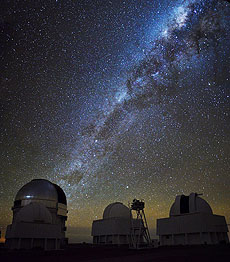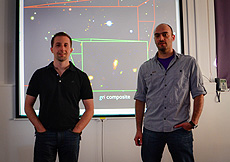Dark Energy Survey discovers exotic type of supernova
 |
| The Milky Way rises over the Cerro Tololo Inter-American Observatory in northern Chile. The Dark Energy Survey operates from the largest telescope at the observatory, the 4-meter Victor M. Blanco Telescope (left). Photo courtesy of Andreas Papadopoulos
|
The first images taken by the Dark Energy Survey after it began in August 2013 have revealed a rare, "superluminous" supernova (SLSN) that erupted in a galaxy 7.8 billion light-years away. The stellar explosion, called DES13S2cmm, easily outshines most galaxies in the universe and could still be seen in the data six months later, at the end of the first of what will be five years of observing by DES.
Supernovae are very bright, shining anywhere from 100 million to a few billion times brighter than the sun for weeks on end. Thousands of these brilliant stellar deaths have been discovered over the last two decades, and the word "supernova" itself was coined 80 years ago. Type Ia supernovae, the most well-known class of supernovae, are used by cosmologists to measure the expansion rate of the universe.
But SLSNe are a recent discovery, recognized as a distinct class of objects only in the past five years. Although they are 10 to 50 times brighter at their peak than type Ia supernovae, fewer than 50 have ever been found. Their rareness means each new discovery brings the potential for greater understanding — or more surprises.
It turns out that even within this select group of SLSNe, DES13S2cmm is unusual. The rate at which it is fading away over time is much slower than for most other SLSNe that have been observed to date. This change in brightness over time, or light curve, gives information on the mechanisms that caused the explosion and the composition of the material ejected. DES can constrain the potential energy source for DES13S2cmm thanks to the exceptional photometric data quality available. Only about 10 SLSNe are known that have been similarly well-studied.
Although they are believed to come from the death of massive stars, the explosive origin of SLSNe remains a mystery. The DES team tried to explain the luminosity of DES13S2cmm as a result of the decay of the radioactive isotope nickel-56, known to power normal supernovae. They found that, to match the peak brightness, the explosion would need to produce more than three times the mass of our sun of the element. However, the model is then unable to reproduce the rate at which DES13S2cmm brightened and faded.
A model that is more highly favored in the literature for SLSNe involves a magnetar: a neutron star that rotates once every millisecond and generates extreme magnetic fields. Produced as the remnant of a massive supernova, the magnetar begins to "spin down" and inject energy into the supernova, making the supernova exceptionally bright. This model is better able to produce the behavior of DES13S2cmm, although neither scenario could be called a good fit to the data.
DES13S2cmm was the only confirmed SLSN from the first season of DES, but several other promising candidates were found that could not be confirmed at the time. More are expected in the coming seasons. The goal is to discover and monitor enough of these rare objects to enable them to be understood as a population.
Although designed for studying the evolution of the universe, DES will be a powerful probe for understanding superluminous supernovae.
—Chris D'Andrea and Andreas Papadopoulos, Institute of Cosmology and Gravitation, University of Portsmouth
 |
| Before (left) and after (center) images of the region where DES13S2cmm was discovered. On the right is a subtraction of these two images, showing a bright new object at the center — a supernova. Image: Dark Energy Survey
|
 |
| The DES13S2cmm superluminous supernova was discovered by Andreas Papadopoulos (right), a graduate student at the University of Portsmouth and lead author on a forthcoming paper about the supernova. Chris D'Andrea (left) is a postdoctoral researcher at Portsmouth and leads the DES supernova spectroscopic follow-up program. Photo courtesy of Andreas Papadopoulos
|
|